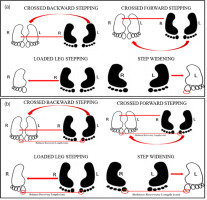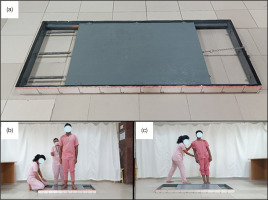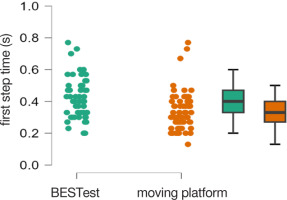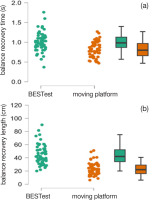Introduction
Stepping is a common strategy used in postural control assessments during stance [1] and walking [2]. However, the evaluation of postural control in clinical settings often overlooks the examination of reactive postural reactions [3–5].
Stepping, which involves creating a new base of support to prevent a fall, is a common strategy, with lateral stepping having distinct biomechanical characteristics and stepping attributes [6]. Lateral balance is particularly challenging in older adults, frequently resulting in hip fractures and other injuries [7]. However, there is a scarcity of studies that have evaluated lateral stepping in response to mediolateral perturbations [8–11].
The Balance Evaluation System Test (BESTest), is one of the commonly used assessment methods for postural control [12]. other methods, such as waist pulls and moving platforms, are also used to assess postural control [5]. However, the BESTest method allows for a certain level of predictability regarding the direction of perturbation, which reduces its potential to truly test an individual’s reactive stepping ability. in contrast, waist pulls and moving platforms provide perturbations that challenge postural control in a manner similar to real-life scenarios. The outcome of the testing may be influenced by the design of the test or the way the perturbations are delivered. ideally, a test should mimic real-life experiences in order to accurately assess an individual’s ability to respond to destabilising events and prevent a fall. We hypothesised that the response to lateral stepping reaction testing in the BESTest and a moving platform may vary in terms of the strategies used, the number of steps and the balance recovery distance and time.
Our intention was to investigate this difference in order to determine which method elicits the best responses from an individual. The outcome of this study will offer valuable insight into the impact of the method of testing on the postural control response and assist therapists in selecting the most appropriate method for assessing reactive postural control.
Subjects and method
Young adults aged between 18 and 26 years, of both genders, who were willing to participate, were screened for inclusion. only those without length discrepancies in the lower limbs and without deformities of the lower limbs and spine were included in the study. individuals with recent surgery, musculoskeletal injuries or cardiorespiratory and neurological conditions that could influence lateral stepping ability or the outcome of the study were excluded from participation.
The details of the study were explained to those who met the inclusion criteria, and informed consent was obtained from all participants. Sixty young adults were included in the study. All participants were tested with the BESTest and perturbations on the moving platform. Lateral stepping towards the right side was tested for all participants using both methods, with three trials given in each test.
Testing lateral stepping to lean and release in the BESTest
Each participant was instructed to perform postural adjustments to prevent a fall. They were asked to stand with feet together and arms at their sides. A therapist stood to the right side of the participant and placed one hand on the right side of the pelvis and the other on the right shoulder. The participant was instructed to lean their body onto the therapist’s hand beyond their sideways limit. After the lean, the participant was asked to relax, and the support was released suddenly by the therapist, triggering the lateral stepping response. The lateral stepping responses were graded according to the BESTest grading system (Figure 1c).
Testing lateral stepping to mediolateral perturbations using the moving platform
For this procedure, a moving platform was constructed from wood, as shown in Figure 1a. The platform had an outer stable rectangular frame (length: 5 feet, breadth: 2.5 feet) and an inner movable platform (length: 3 feet, breadth: 2 feet). The inner platform on one side was connected to the outer frame through three springs (0.5 feet), and on the other side, it was attached to a spring weighing scale and a release mechanism.
The participant stood on the platform barefoot and comfortably. A therapist positioned themselves alongside the participant to mitigate the risk of falls during the testing procedure. Clear guidance was provided, emphasising that surface translation could occur at any moment, and participants were instructed to respond accordingly to prevent falls. Another therapist triggered the movement of the platform by pulling the end of the platform connected to the spring weighing scale. The magnitude of this pulling force was measured using the spring weighing scale. A preliminary study with 15 young adults determined that a minimum of 15% of body weight was required to provoke a lateral stepping response. This force was used as the minimum threshold in the present study. once 15% of body weight was registered on the spring weighing scale, the therapist secured the release mechanism. For some participants, the perturbation force was increased by increments of 5% of body weight if the stepping response was not elicited. The platform movement was initiated towards the left side of the participant to trigger a right lateral step (Figure 1b).
Analysis of spatio-temporal parameters of lateral stepping
The trails of the lateral stepping responses were video recorded. The distance between the camera (35-megapixel) and the participant was maintained at 7 feet along the floor, with the participant centred in the screen using in-screen grid lines. The spatio-temporal parameters of stepping were analysed using “TRACKER” software, version 6.1.2 (https://physlets.org/tracker/). First step time was calculated from the moment a limb was unloaded to the point at which the participant placed the unloaded limb back onto the ground. Balance recovery time was measured from the moment a limb was unloaded to the point at which no further limb movements were executed to regain balance. Balance recovery length was measured from the initial position of the left limb’s big toe to the final position of the right limb’s greater toe after the participant achieved a stable position following the perturbation (see Figure 2b). For statistical analysis, the trial with the minimum values for these parameters was selected from the three trials conducted. The difference in the number of steps taken during this assessment was documented, along with the characteristics of the stepping and the number of steps taken to recover balance, as shown in Figure 2a.
Figure 2
(a) four different types of lateral stepping characteristics, (b) balance recovery length measured in TRACKER software

Results
Sixty healthy young adults (29 male, 31 female) were enrolled in the study. The mean age of the participants was 20.45 years, and their mean weight was 60.42 ± 0.18 kg.
Four common patterns of lateral stepping response were identified (Figure 1a): crossed backwards stepping, crossed forwards stepping, loaded leg stepping and step widening. These responses pertained to the first step taken by the participants. in “crossed backwards” or “crossed forwards” stepping, the left leg was moved backwards or forwards relative to the right leg to create a new base of support, followed by the repositioning of the right leg. in “loaded leg” stepping, the right leg was moved to increase the base of support. in “step widening”, the left leg was moved away from the right leg to increase the base of support.
The mean values of first step time (s), balance recovery length (cm) and balance recovery time (s) were higher in the BESTest method compared to the moving platform perturbation method (Table 1).
Table 1
Spatiotemporal characteristics of reactive lateral stepping
| Spatiotemporal characteristics | Moving platform (mean ± SD) | BESTest (mean ± SD) | p |
|---|---|---|---|
| FST (s) | 0.34 ± 0.12 | 0.41 ± 0.12 | < 0.001 |
| BRL (cm) | 23.13 ± 9.24 | 44.61 ± 14.73 | < 0.001 |
| BRT (s) | 0.81 ± 0.19 | 1.00 ± 0.24 | < 0.001 |
Raincloud graphs were plotted to visualise the difference in spatio-temporal parameters of lateral stepping provoked by the BESTest and moving platform.
Lateral stepping characteristics
Multiple steps were taken by the majority of participants in the BESTest method compared to the moving platform. However, it was observed that the same participants recovered their balance with a single step in both methods (Table 2). Six participants demonstrated multiple steps in both assessments. Thirteen participants demonstrated recovery of balance with a single step in both assessments. The method of lateral stepping response also differed between the testing procedures (Table 3). Approximately 43% of the participants required 20% of their body weight to be applied to the moving platform to trigger a stepping response, followed by 31% of participants who required 25% of their body weight (Table 4).
Table 2
Cross tabulation of participants based on the number of steps taken during the moving platform and BESTest perturbations
| BESTest | Moving platform | |
|---|---|---|
| single step | multiple steps | |
| Single step | 13 | 1 |
| Multiple steps | 40 | 6 |
Table 3
Cross tabulation of the number of participants based on lateral stepping characteristics in the moving platform and BESTest
Discussion
The present study analysed the spatiotemporal parameters of lateral stepping and found that the moving platform yielded smaller values for all the tested parameters when compared to the BESTest method.
The balance recovery length was shorter in the moving platform compared to the BESTest method. This disparity can be attributed to the initial position of the participant when the perturbation was applied. in the BESTest, the participant was instructed to lean towards the right side before the release to trigger stepping, whereas in the moving platform, the participant was instructed to stand upright. Hsiao-Wecksler et al. [13] state that the release angle of an individual can influence the length of the step. The starting angle of inclination in the BESTest may have resulted in an increased step length compared to the moving platform.
The time taken for the first step and balance recovery was found to be shorter in the moving platform. According to Verniba et al. [14], platform perturbations resulted in a smaller margin of stability compared to shoulder pull perturbations. The platform perturbations were considered more challenging for participants to respond to than shoulder pulls, which may explain the shorter first step time in platform perturbations. Afschrift et al. [15] state that the more reactive the step, the less time it takes to initiate. These findings support the results of the present study, which shows shorter times for the first step and balance recovery in the moving platform method compared to the BESTest.
Forty participants who exhibited a single-step response in the moving platform subsequently demonstrated a multiple-step response in the BESTest. Previous research has indicated that the number of steps taken can differentiate between fallers and non-fallers [5]. The findings of the current study suggest that the method of assessment should be considered a factor when interpreting results to classify fallers and non-fallers, because it is likely to influence the frequency of steps. Adams et al. [5] used moving platform to elicit a stepping response and compared it with balance measures such as the Brief BESTest and Timed Up and Go test. The authors concluded that the stepping threshold test using moving platform had convergent validity with other balance tests but was unable to differentiate between fallers and non-fallers. We hypothesise that the limited space provided by the moving platform may have compelled participants to modify their response by taking fewer steps. in the moving platform, participants were required to perform within the confines of the platform, whereas in the BESTest, they had the freedom to respond with a larger space. if this explanation for the variation in response is accepted, it reflects the individual’s capacity to respond in a constrained environment, exhibiting their optimal ability to react. Although we did not explicitly instruct participants to refrain from stepping outside of the moving platform during testing, only one participant did so, while others remained within the platform.
Percentage of body weight was employed as a measure to trigger stepping on the moving platform. Similarly, the spring scale test also used percentage of body weight to induce perturbations [16]. A cut-off of 10% of body weight was identified as a discriminatory threshold to distinguish fallers. in the present study, the majority of participants required 20% of their body weight to elicit a response on the moving platform. Although the point of application of force differs between the spring scale test and the moving platform, the percentage of body weight serves as a comparative or recordable measure for individuals to resist perturbation. The increase in body weight percentage observed in this study may be attributed to the younger age of the participants compared to those in the spring scale test study.
The findings of this study demonstrate that alterations in the assessment strategy are likely to influence the stepping behaviour of individuals. Because reactive stepping plays a crucial role in fall prevention, it is imperative to employ an assessment strategy that can elicit the most optimal stepping behaviour and provide insights into an individual’s capabilities. This study has revealed that the use of the moving platform elicited the most optimal stepping behaviour compared to the lean-release method in the BESTest.
Clinical implications
It is recommended that the assessment of reactive stepping strategies preferably employ techniques such as a moving platform to elicit responses that closely resemble real-life scenarios. Additionally, incorporating video analytics and simple software can enhance the objectivity of the assessment.
Conclusions
Lateral stepping responses in the BESTest and the moving platform differed in terms of strategies used, number of steps, balance recovery distance and time. The implementation of a moving platform yielded the most proficient stepping ability, as reflected in the number of steps, balance recovery distance and time.




